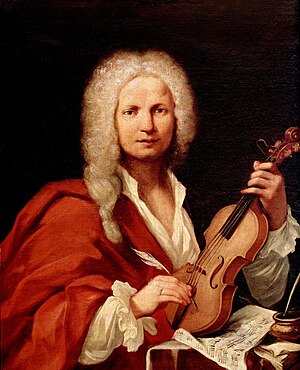 Image via Wikipedia(Text in Large Print for Classroom Projection)
Image via Wikipedia(Text in Large Print for Classroom Projection)Bach
DOB 1685-1750, German
Major Works: Brandenberg concertos, Toccato and Fugue, Well-Tempered Clavier, cantatas
Background: Part of a musical family. Even Bach's children continued with composition. Started as a church organist, later became a concertmaster in Weimer. His church position at St. Thomas was where he wrote many of his most famous works. He was a teacher and prominent organist. In fact, he was better known for his organ playing than his composition. It wasn't until the 1800s when Felix Mendelssohn rediscovered Bach that Baroque music again became popular. During his lifetime, Bach was only known in his own region. Wrote in every genre except opera.
http://www.youtube.com/watch?v=hZ9qWpa2rIg
http://www.youtube.com/watch?v=rXSp8Oi6vYc
http://www.youtube.com/watch?v=eQ4Og9LNJpk
George Frederic Handel
DOB 1685-1759, Germany
Major Works: Messiah
Background: Child prodigy, violinist and harpsichord. First opera by the time he was 20. Moved to Italy and wrote many operas. Then moved to England where he became a court favorite (Queen Anne). He wrote operas and oratorios. His most famous is the Messiah, but he also wrote Israel in Egypt and Joshua. +
DOB 1685-1759, Germany
Major Works: Messiah
Background: Child prodigy, violinist and harpsichord. First opera by the time he was 20. Moved to Italy and wrote many operas. Then moved to England where he became a court favorite (Queen Anne). He wrote operas and oratorios. His most famous is the Messiah, but he also wrote Israel in Egypt and Joshua. +
http://www.youtube.com/watch?v=76RrdwElnTU
http://www.youtube.com/watch?v=gIpXEVuiDDU&feature=related
http://www.youtube.com/watch?v=OT1oTBSqR4E&feature=fvst
Monteverdi
DOB 1567-1643, Italy
Major Works: The Opera Orfeo
Background: Worked for two decades at the royal court in Mantua. Moved to St. Mark's after a nervous breakdown. Became the most important composer in Italy. First opera composer. He wrote a dozen operas, all in native Italian.
Orfeo: Gifted musician of Greek mythology. Orpheus goes into the underworld to find his blessed bride, who has been killed. He tries to rescue his Eurydice, but before he and she escape, he breaks the one rule "Do not look back". He looks at his bride and loses her forever. Composed in 1607 when he was working at Mantua.
Arias (Solo voice with orchestral accompaniment)
Recitative (Vocal line which attempts to imitate speech)
Chorus
Duet
Interludes (instruments)
Bass Ostinato (repetitive bass line)
http://www.youtube.com/watch?v=p7fhbKsdvBA&feature=fvst
http://www.youtube.com/watch?v=uhj0TY8ZpMo
Henry Purcell
DOB 1659-1695, England
Major Works: Opera "Dido and Aeneus"
Background: Organist. Worked at Westminister Abbey and for the king
http://www.youtube.com/watch?v=4gyQWW_OC_4
Recitative
Thy hand, Belinda, darkness shades me,
On thy bosom let me rest,
More I would, but Death invades me;
Death is now a welcome guest.
http://www.youtube.com/watch?v=gIpXEVuiDDU&feature=related
http://www.youtube.com/watch?v=OT1oTBSqR4E&feature=fvst
Monteverdi
DOB 1567-1643, Italy
Major Works: The Opera Orfeo
Background: Worked for two decades at the royal court in Mantua. Moved to St. Mark's after a nervous breakdown. Became the most important composer in Italy. First opera composer. He wrote a dozen operas, all in native Italian.
Orfeo: Gifted musician of Greek mythology. Orpheus goes into the underworld to find his blessed bride, who has been killed. He tries to rescue his Eurydice, but before he and she escape, he breaks the one rule "Do not look back". He looks at his bride and loses her forever. Composed in 1607 when he was working at Mantua.
Arias (Solo voice with orchestral accompaniment)
Recitative (Vocal line which attempts to imitate speech)
Chorus
Duet
Interludes (instruments)
Bass Ostinato (repetitive bass line)
http://www.youtube.com/watch?v=p7fhbKsdvBA&feature=fvst
http://www.youtube.com/watch?v=uhj0TY8ZpMo
Henry Purcell
DOB 1659-1695, England
Major Works: Opera "Dido and Aeneus"
Background: Organist. Worked at Westminister Abbey and for the king
http://www.youtube.com/watch?v=4gyQWW_OC_4
Recitative
Thy hand, Belinda, darkness shades me,
On thy bosom let me rest,
More I would, but Death invades me;
Death is now a welcome guest.
Aria
When I am laid, am laid in earth, May my wrongs create
No trouble, no trouble in thy breast;
Remember me, remember me, but ah! forget my fate.
Remember me, but ah! forget my fate,
Dido and Aeneus
Short opera. Most roles are written for women (composed for a girl's boarding school). Based on Virgil's poem about the Queen of Carthage (Dido) and her failed romance with the King Aeneus (king of the Trojans). After he leaves her, because of evil witches conniving, Dido sings a lament and commits suicide.
Antonio Vivaldi
DOB (1678-1741), Italy
Major Works: The Four Seasons
Background: Called the Red Priest (he was a redhead). Taught at an orphanage for girls. Wrote many beautiful works for an orchestra of forty young women. Died in poverty. He is best known for solo concertos (soloist with orchestra) and concerti grosso). (pg 125 more info, Kamien).
Fun Fact
http://www.youtube.com/watch?v=G8Ja8SqMwM0
When I am laid, am laid in earth, May my wrongs create
No trouble, no trouble in thy breast;
Remember me, remember me, but ah! forget my fate.
Remember me, but ah! forget my fate,
Dido and Aeneus
Short opera. Most roles are written for women (composed for a girl's boarding school). Based on Virgil's poem about the Queen of Carthage (Dido) and her failed romance with the King Aeneus (king of the Trojans). After he leaves her, because of evil witches conniving, Dido sings a lament and commits suicide.
Antonio Vivaldi
DOB (1678-1741), Italy
Major Works: The Four Seasons
Background: Called the Red Priest (he was a redhead). Taught at an orphanage for girls. Wrote many beautiful works for an orchestra of forty young women. Died in poverty. He is best known for solo concertos (soloist with orchestra) and concerti grosso). (pg 125 more info, Kamien).
Fun Fact
http://www.youtube.com/watch?v=G8Ja8SqMwM0



Comments